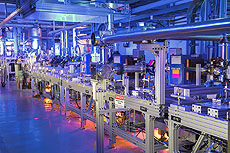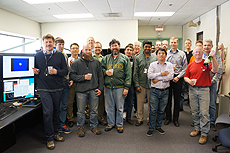Superconducting test accelerator achieves first electron beam
 |
| Last week the first SRF cavities of Fermilab's superconducting test accelerator propelled their first electrons. Photo: Reidar Hahn |
The newest particle accelerators and those of the future will be built with superconducting radio-frequency (SRF) cavities, and institutions around the world are working hard to develop this technology. Fermilab's advanced superconducting test accelerator was built to take advantage of SRF technology accelerator research and development.
On Friday, after more than seven years of planning and building by scientists and engineers, the accelerator has delivered its first beam.
The Fermilab superconducting test accelerator is a linear accelerator (linac) with three main components: a photoinjector that includes an RF gun coupled to an ultraviolet-laser system, several cryomodules and a beamline. Electron bunches are produced when an ultraviolet pulse generated by the laser hits a cathode located on the back plate of the gun. Acceleration continues through two SRF cavities inside the cryomodules. After exiting the cryomodules, the bunches travel down a beamline, where researchers can assess them.
Each meter-long cavity consists of nine cells made from high-purity niobium. In order to become superconductive, the cavities sit in a vessel filled with superfluid liquid helium at temperatures close to absolute zero.
As RF power pulses through these cavities, it creates an oscillating electric field that runs through the cells. If the charged particles meet the oscillating waves at the right phase, they are pushed forward and propelled down the accelerator.
The major advantage of using superconductors is that the lack of electrical resistance allows virtually all the energy passing through to be used for accelerating particle beams, ultimately creating more efficient accelerators.
"It's more bang for the buck," said Elvin Harms, one of the leaders of the commissioning effort.
The superconducting test accelerator's photoinjector gun first produced electrons in June 2013. In the current run, electrons are being shot through one single-cavity cryomodule, with a second, upgraded model to be installed in the next few months. Future plans call for accelerating the electron beam through an eight-cavity cryomodule, CM2, which was the first to reach the specifications of the proposed International Linear Collider (ILC).
Fermilab is one of the few facilities that provides space for advanced accelerator research and development. These experiments will help set the stage for future superconducting accelerators such as SLAC's Linac Coherent Light Source II, of which Fermilab is one of several partner laboratories.
"The linac is similar to other accelerators that exist, but the ability to use this type of setup to carry out accelerator science experiments and train students is unique," said Philippe Piot, a physicist at Fermilab and professor at Northern Illinois University leading one of the first experiments at the test accelerator. A Fermilab team has designed and is beginning to construct the Integrable Optics Test Accelerator ring, a storage ring that will be attached to the superconducting test accelerator in the years to come.
"This cements the fact that Fermilab has been building up the infrastructure for mastering SRF technology," Harms said. "This is the crown jewel of that: saying that we can build the components, put them together, and now we can accelerate a beam."
—Diana Kwon
 |
| The superconducting test accelerator team celebrates first beam in the operations center at NML. Vladimir Shiltsev, left, is pointing to an image of the beam. Photo: Pavel Juarez, AD |
|